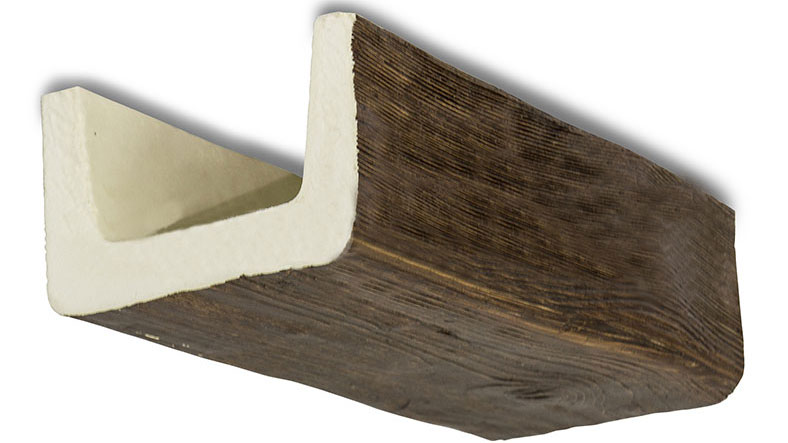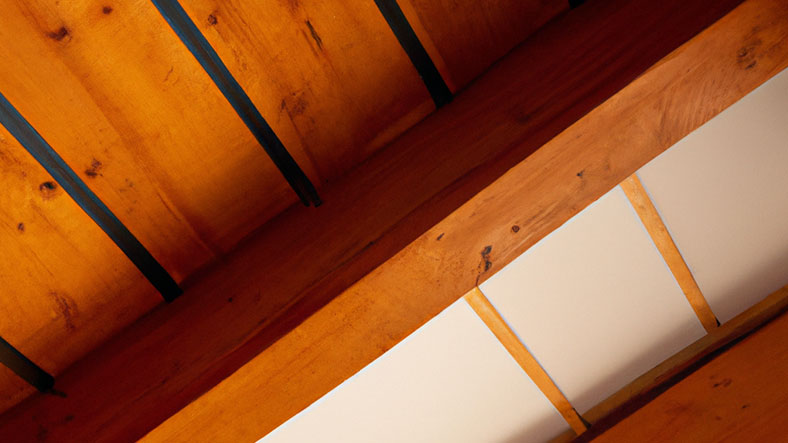Faux wood beams are gaining prominence in the world of interior design and decoration. Especially among those who want to create rustic style environments at home, but without the drawbacks of natural wood.
Are you one of them? In that case, you are interested in what we are going to tell you in ParaTuReforma. We dedicate this article to tell you what are the false wooden beams, what materials are used for their manufacture and how they are installed. Do not miss it.

False wooden beams
Beams are rigid architectural elements that were usually placed horizontally on roofs. Their purpose was to support and transmit the transverse loads to the columns or other supporting devices.
When they are made of wood, they are very attractive aesthetically. In fact, old houses that still have them are highly valued. However, they have certain disadvantages:
- A lot of maintenance. It is usual to have to apply special treatments every few years to prevent, for example, the wood from losing its original properties.
- There is a risk of rotting. Especially, if there is a problem in the roof that favors the entrance of water. This is an inconvenience that, in most cases, has no solution.
- Difficult installation. Do not forget that wooden beams are quite heavy, which makes them difficult to install. Although they do not bear loads and play only a decorative role.
- High price. Wood is quite expensive compared to the materials used in imitation beams.
Imitation wood beams perfectly emulate the aesthetics of natural wood. In fact, at first glance, it is impossible to differentiate them from the originals. In addition, they do not have any of the disadvantages mentioned above, nor do they play any structural role in the building. This is the main reason why they have become protagonists in rustic environments.
Materials
There are two materials commonly used in the manufacture of imitation wood beams. The first of these is high-density polyurethane. It stands out, mainly, for:
- It is very malleable and flexible. It is not for nothing that it is possible to find fake wooden beams with square and half-round shapes.
- It offers good thermal and acoustic insulation properties.
- It is abrasion, shock and tear resistant.
- It is one hundred percent waterproof.
However, nowadays there are a multitude of techniques that allow us to print an aesthetic very similar to that of natural wood. The same can be said about polystyrene, which is the other most commonly used material for this purpose.
The quality of the dummy beam is largely determined by the density and thickness of the material. It is possible to find it in various lengths. It is usually between 2 and 6 meters.
Obviously, since these are relatively standard sizes, there will be times when it will be necessary to cut the beams. This is not a problem when using the materials mentioned above. At the ends that touch the walls, pieces called finials or brackets must be placed. This is the only way to achieve the perfect finish.
Installation techniques
There are two ways to install fake wood beams. We are going to explain them now so that you can decide which one suits you better. Of course, both are so simple that you can even do them yourself, even if you don’t have a great knowledge of do-it-yourself.
1. Installation of false wooden beams with wooden dowels
It is the safest way to proceed with its placement, although it is also the most complex. For this, you will need:
- One meter.
- A drill.
- Plastic blocks.
- Lag screws.
- Wooden plugs with click systems.
- A ladder.
- A little putty in the same color as the beam.
Have you got it all? Then it’s time for you to get down to work:
- Measure the total length of the ceiling and then make a mark every 70 centimeters.
- Draw a straight line to serve as a guide for the subsequent placement of the beams.
- Use the drill to drill holes for the dowels that will hold the beam. Use lag screws to make sure you have a good hold.
- Snap each joist into the ceiling. The click system of the dowels will hold them securely in place.

When you’re done, take a look from the ladder for any imperfections. Then hide them by applying a little putty and you’re done.
2. Installation of false wooden beams with adhesive
This alternative may be more interesting than the previous one when the false beams are going to have a reduced size and, consequently, a rather low weight. Specifically, what you should do is the following:
- Clean the ceiling thoroughly. Be sure to remove any impurities or dirt, otherwise the glue may not adhere well.
- As in the previous case, make a mark every 70 centimeters to determine the position of the beams.
- Put the adhesive on the surface of the beams that will come into contact with the ceiling and glue them.
- Finally, use putty to hide the imperfections.
There are imitation wood beams that incorporate the adhesive required for placement. However, if the model you like does not come with it, do not worry. You just need to go to a hardware store, explain the situation to the clerk and let him advise you. He will tell you which glue is the most suitable for you in this case.
Do you want to know more about fake wooden beams or are you definitely decided to buy them? In any case, from here we invite you to contact us. In ParaTuReforma we can not only offer you quality advice to help you choose the right model for you from our catalog, but we can also prepare a personalized quote quickly and without obligation.


